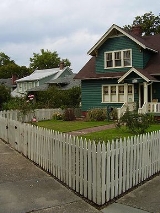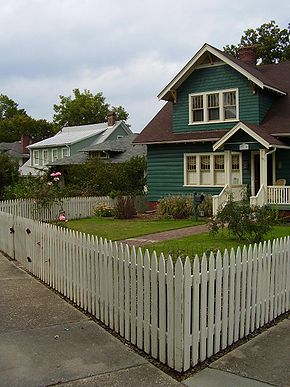
Fisher Park, Greensboro, North Carolina
Encyclopedia
Fisher Park is a neighborhood
in the north central section of the United States
city of Greensboro, North Carolina
. Captain Basil J. Fisher turned a swamp into Greensboro's most fashionable Gilded Era address in 1901 when he donated the lowlands for a city park that bears his name. Residents took full advantage of ample lots overlooking the park by commissioning the city's best architects to design sometimes palatial homes. The neighborhood is recognized as Greensboro's first suburb, and is the city's most popular historic district.
 With the establishment of the convenient trolley line through the heart of the neighborhood in 1902, industrialists, bankers, and professionals erected homes based on popular national styles such as Frank Lloyd Wright-influenced Prairie style, California-based Craftsmen style, and New England-inspired Colonial Revival styles. The district remained the epicenter of Greensboro's cultural elite until it was overshadowed by Irving Park, just a mile to the north.
With the establishment of the convenient trolley line through the heart of the neighborhood in 1902, industrialists, bankers, and professionals erected homes based on popular national styles such as Frank Lloyd Wright-influenced Prairie style, California-based Craftsmen style, and New England-inspired Colonial Revival styles. The district remained the epicenter of Greensboro's cultural elite until it was overshadowed by Irving Park, just a mile to the north.
The 1950s and 60s brought challenges to the neighborhood bordering Greensboro's center city as office development threatened to replace historic homes. Efforts to regulate development and change advanced in 1982 when the neighborhood was designated as Greensboro's second historic district. Since then, the rate of destruction of historic homes has slowed (but not halted), the park has received a much needed make-over, and land values have spiraled upwards.
Fisher Park remains a popular destination for city residents who walk the tree-lined streets and lush park during lunchtime, attend occasional house tours, and enjoy a shaded diversion during summer heat. The district enjoys a wide diversity of private historic homes, some dating back to the nineteenth century, such as The Elms at 220 Fisher Avenue, the Dixon-Leftwich-Murphy House at 507 Church Street, and the Cumming House at 908 Cherry Street. Other houses represent a broader spectrum of twentieth century styles, including the Tudor-style Galloway House at 1007 North Elm Street, the prairie-styled Latham-Baker House at 412 Fisher Park Circle, the Classical Revival-style Henry C. Simpson House at 117 East Hendrix Street (circa 1906) and the charming Spanish-style Casa Sevilla Apartments on Bessemer Court (all private).
Neighbourhood
A neighbourhood or neighborhood is a geographically localised community within a larger city, town or suburb. Neighbourhoods are often social communities with considerable face-to-face interaction among members. "Researchers have not agreed on an exact definition...
in the north central section of the United States
United States
The United States of America is a federal constitutional republic comprising fifty states and a federal district...
city of Greensboro, North Carolina
North Carolina
North Carolina is a state located in the southeastern United States. The state borders South Carolina and Georgia to the south, Tennessee to the west and Virginia to the north. North Carolina contains 100 counties. Its capital is Raleigh, and its largest city is Charlotte...
. Captain Basil J. Fisher turned a swamp into Greensboro's most fashionable Gilded Era address in 1901 when he donated the lowlands for a city park that bears his name. Residents took full advantage of ample lots overlooking the park by commissioning the city's best architects to design sometimes palatial homes. The neighborhood is recognized as Greensboro's first suburb, and is the city's most popular historic district.
Boundaries
Fisher Park is bounded as follows:- on the north by Wendover Avenue;
- on the west by the Green Hill Cemetery;
- on the east by the Southern Railway tracks; and
- on the south by the central business district and Smith Street.
History

The 1950s and 60s brought challenges to the neighborhood bordering Greensboro's center city as office development threatened to replace historic homes. Efforts to regulate development and change advanced in 1982 when the neighborhood was designated as Greensboro's second historic district. Since then, the rate of destruction of historic homes has slowed (but not halted), the park has received a much needed make-over, and land values have spiraled upwards.
Fisher Park remains a popular destination for city residents who walk the tree-lined streets and lush park during lunchtime, attend occasional house tours, and enjoy a shaded diversion during summer heat. The district enjoys a wide diversity of private historic homes, some dating back to the nineteenth century, such as The Elms at 220 Fisher Avenue, the Dixon-Leftwich-Murphy House at 507 Church Street, and the Cumming House at 908 Cherry Street. Other houses represent a broader spectrum of twentieth century styles, including the Tudor-style Galloway House at 1007 North Elm Street, the prairie-styled Latham-Baker House at 412 Fisher Park Circle, the Classical Revival-style Henry C. Simpson House at 117 East Hendrix Street (circa 1906) and the charming Spanish-style Casa Sevilla Apartments on Bessemer Court (all private).
Notable architects and builders
- Hobart Upjohn
- Charles C. Hartmann
- Harry Barton
- Raleigh James Hughes
- Wells L. Brewer
- Andrew Leopold Schlosser
- Lorenzo S. Winslow
Other notable civic institutions
- First Presbyterian Church of Greensboro
- Holy Trinity Episcopal Church
- Temple Emanuel

